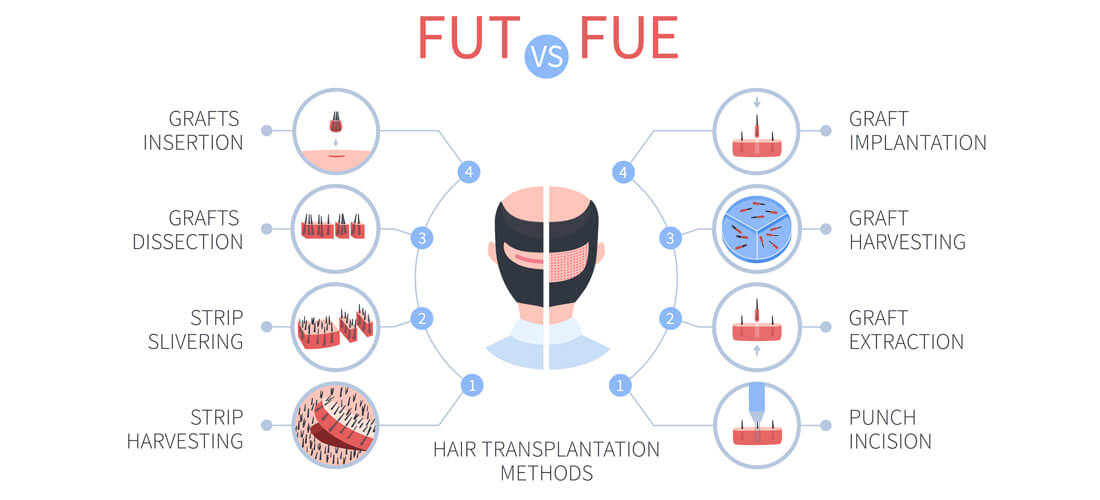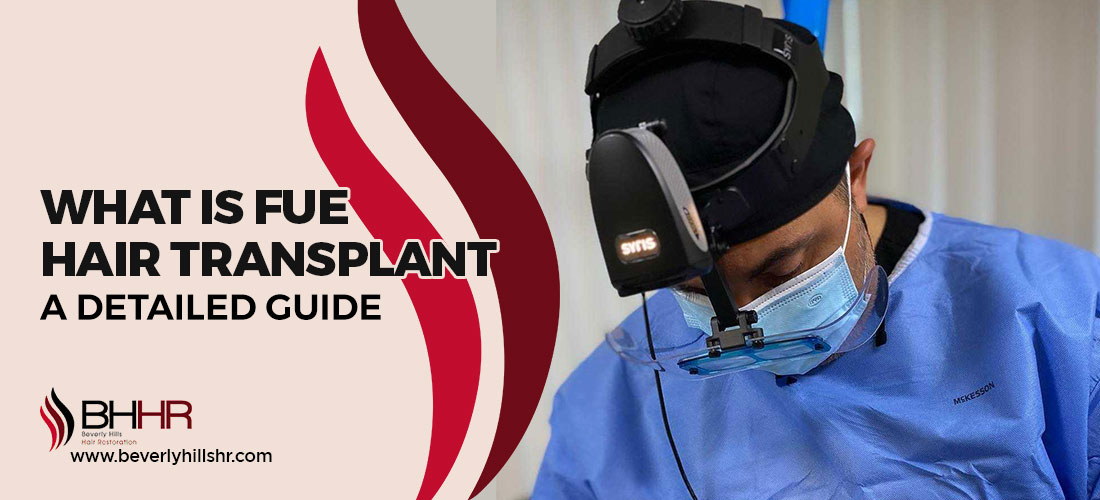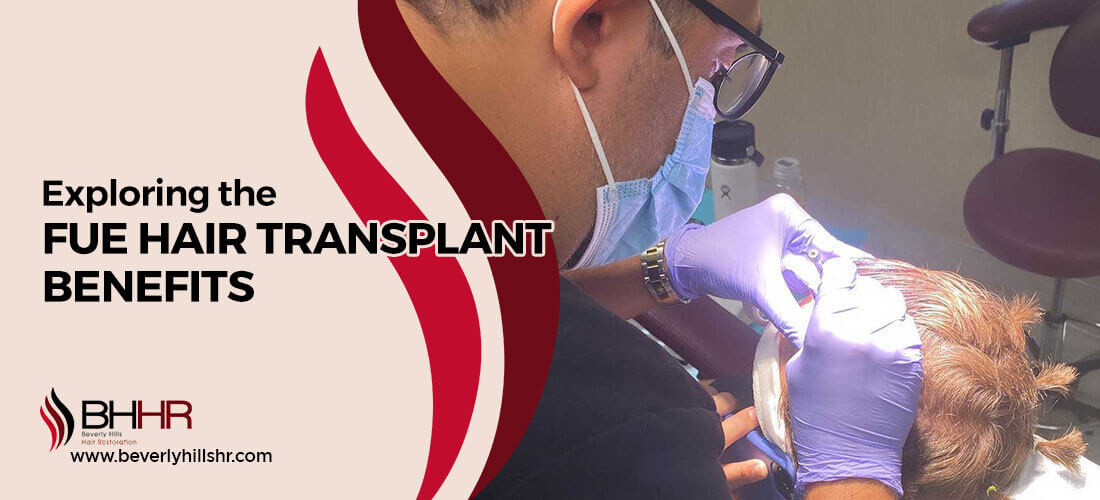FUE Vs FUT Hair Transplant: Which Is Better For You?
Home / FUE Hair Transplant / FUE Vs FUT Hair Transplant: Which Is Better For You?
Updated On : July 16, 2024 | Category : FUE Hair Transplant | Author: Beverly Hills Hair Restoration Team

In hair restoration, two techniques stand out: FUT Hair Transplant (Follicular Unit Transplantation) and FUE Hair Transplant (Follicular Unit Extraction). Both methods offer unique advantages and cater to different needs, but choosing the right one depends on various factors, including personal goals, hair type, and lifestyle. At Beverly Hills Hair Restoration in Los Angeles, Dr. John Kahen expertly performs both procedures, leveraging each technique's strengths to meet the individual expectations of his patients.
Understanding FUE Hair Transplant
FUE (Follicular Unit Extraction) extracts individual hair follicles directly from the scalp, bypassing the need to remove a strip of skin and providing a less invasive option for hair restoration. This technique is less invasive than FUT hair transplant, offering the advantage of no linear scarring and shorter recovery times. It suits patients who wish to wear short hair or prefer a less invasive procedure.
Understanding FUT Hair Transplant
In FUT (Follicular Unit Transplantation), often called strip surgery, a precise strip of scalp is delicately harvested from the back of the head. From this strip, individual hair follicles are meticulously extracted and then strategically transplanted into areas affected by baldness. With this approach, numerous grafts can be transplanted in one session, catering to individuals desiring significant enhancements in hair density. However, it does leave a linear scar, which can be a consideration for those who prefer short hairstyles.
Pioneering Smart FUE & FUT Techniques at Beverly Hills Hair Restoration
At Beverly Hills Hair Restoration, we stand alone in the global landscape of hair restoration thanks to our innovative Smart FUE and FUT Hair Transplant techniques, exclusively developed and patented by Dr. John Kahen. Our hair transplant clinic is the only one in the world utilizing these advanced methods, integrating the power of platelet-rich plasma therapy into the hair transplant process. This unique approach involves enriching the transplant area with specially formulated plasma that significantly enhances the healing and growth phases, ensuring superior results.
Our Smart FUE and FUT techniques leverage the regenerative properties of platelet-rich plasma (PRP), prepared using a proprietary process that concentrates growth factors more effectively than standard PRP treatments.
FUE Vs FUT Hair Transplant Benefits
Understanding the FUE vs FUT benefits can assist you in making an informed choice regarding your hair transplant. At Beverly Hills Hair Restoration, we specialize in FUE Hair Transplant and FUT Hair Transplant techniques, providing our patients with tailored options to meet their hair restoration needs best.
For a detailed comparison of the benefits of each method, continue reading below:
| Benefit | FUE | FUT |
|---|---|---|
| Scarring | Leaves minimal, punctate scars that are hardly noticeable, even with short haircuts, providing more flexibility in hair styling. | The procedure results in a linear scar at the donor site, easily hidden by longer hair, ensuring discreet and natural-looking outcomes. However, individuals who prefer short hairstyles might find this less ideal. |
| Procedure Time | Each graft is individually extracted, making the procedure longer but eliminating the need for a linear incision, resulting in a less invasive experience. | Typically, it allows for more grafts to be harvested and transplanted in a single session, making it efficient for extensive hair loss. |
| Ideal Candidates | This is particularly advantageous for patients seeking a minimally invasive option with less downtime and those who wear their hair short. | It is best suited for patients who require a significant volume of hair restoration and are less concerned about shaving their head or a scar. |
| Hair Density | While slightly less density may be achieved than FUT, FUE Hair Transplant offers more flexibility in donor site selection and is ideal for detailed work. | It can achieve high density in targeted areas, making it an excellent option for those with significant balding who wish for a dramatic transformation. |
| Recovery Time | Experience faster recovery with minimal discomfort, enabling a swift return to daily routines post-surgery. | The recovery period is longer due to the need to heal from the surgical excision of a skin strip. Patients may experience more discomfort initially. |
FUE Vs Fut Hair Transplant Procedure
The comparison of the FUE vs FUT procedure is crucial for individuals considering hair transplant options. Our hair transplant doctor, Dr. John Kahen, at Beverly Hills Hair Restoration meticulously explains the differences between Follicular Unit Extraction (FUE) and Follicular Unit Transplantation (FUT), ensuring patients are well-informed about their options. Under his expert guidance, you can assess which method aligns best with your hair restoration goals and lifestyle, providing clarity and confidence in your decision-making process.
Important Note: At Beverly Hills Hair Restoration, our approach to FUE Hair Transplant and FUT Hair Transplant procedures stands out due to our unique use of our patented Smart PRP technology. We enhance the standard process in both procedures by injecting specially formulated plasma into the treatment areas. This plasma, enriched with growth factors through our Smart PRP technique, significantly improves the healing and regeneration capabilities of the transplant site. Injecting Platelet-Rich Plasma or any other factors during a hair restoration procedure is prohibited by any other clinic due to our patented technology and technique.
Read more details below to delve into the specifics and comprehensively understand each technique's nuances.
| Aspect | FUE | FUT |
|---|---|---|
| Technique | Utilizes a punch tool to extract individual hair follicles directly from the scalp, bypassing the need for a strip of skin to be removed. This technique is praised for its precision and minimal invasiveness. | This procedure entails extracting a strip of skin from the back of the scalp containing hair follicles, which are then meticulously dissected into individual units. This traditional method is efficient for harvesting a large volume of grafts. |
| Duration | FUE procedures tend to take longer as each follicle is individually harvested, which can extend the duration of the surgery, especially for large areas. | The FUT Hair Transplant method is generally faster in surgery when many grafts are needed because it simultaneously prepares multiple follicles. |
| Anesthesia | Local anesthesia, sometimes combined with sedation, is used to minimize discomfort as each follicle is individually extracted. | To ensure patient comfort, local anesthesia is administered to numb the donor area before the strip is excised, guaranteeing a pain-free experience during the procedure. |
| Graft Quality | The quality of FUE grafts is high, and careful handling ensures the integrity of each extracted follicle, minimizing transaction rates. | It provides high-quality grafts with a robust structure, as the strip method allows for a controlled environment for dissecting follicles. |
| Patient Comfort | FUE is renowned for its minimal invasiveness, significantly reducing post-operative discomfort and making the recovery process smoother for the patient. | Although more invasive than FUE, advancements in technique and pain management have significantly improved patient comfort during and after the procedure. |
Fue Vs Fut Hair Transplant Recovery Time
In the FUE vs FUT recovery time, experiences for FUT and FUE vary, offering different timelines and considerations. It's important for patients to understand these distinctions to manage expectations and plan their recovery effectively. At Beverly Hills Hair Restoration, Dr. John Kahen enhances the healing process by incorporating Smart PRP plasma into both FUE and FUT procedures. This advanced method significantly improves recovery times by stimulating faster healing and reducing inflammation. With the integration of plasma, patients not only experience quicker recovery but also enjoy enhanced results, making their journey towards regaining fuller hair smoother and more effective.
This innovative approach ensures that each patient receives the best possible care and outcomes tailored to their specific needs.
| Aspect | FUE | FUT |
|---|---|---|
| Immediate Post-Op | Swelling and discomfort are typically less pronounced, with many patients noting quicker subsidence of post-operative symptoms. | Due to the linear incision, patients may experience swelling and discomfort in the donor area, and the initial healing process may take longer. |
| Return to Work | Many patients find they can return to work and light activities within a few days, thanks to the less invasive nature of the procedure. | Recovery guidelines may recommend taking a week or more off work, especially for physically demanding occupations, for optimal incision site healing. |
| Activity Restrictions | Patients can often resume most daily activities and light exercise sooner than with FUT Hair Transplant, with fewer limitations on physical exertion. | Strenuous activities and heavy lifting are usually restricted for several weeks to prevent strain on the sutures and ensure optimal healing. |
| Healing of Donor Area | The donor area heals quickly with tiny, virtually undetectable scars, offering a significant cosmetic advantage for those preferring shorter haircuts. | The linear scar requires careful management and more time to heal fully. Hair growth can eventually conceal the scar for most hairstyles. |
| Final Results | Although the recovery is quicker, the hair growth and final results timeline aligns closely with FUT, allowing patients to enjoy their new look within the same timeframe. | The timeline for seeing the final results is similar for both methods, with initial hair growth observable at 3-4 months and significant results by 9-12 months. |
FUE vs. FUT Hair Transplant Cost Comparison:
Understanding the FUE vs FUT cost is crucial for those considering a hair transplant cost. At Beverly Hills Hair Restoration, Dr. John Kahen ensures that every patient receives a clear and detailed breakdown of costs associated with each method. This transparency helps patients make informed financial decisions about their hair restoration journey. With precise information provided by our hair transplant clinic, you can weigh the benefits and costs of each technique to choose the best option for your needs and budget.
To explore the detailed comparison of FUE and FUT costs, continue reading below:
| Aspect | FUE | FUT |
|---|---|---|
| Per Graft Cost | At Beverly Hills Hair Restoration, the cost per graft for FUE (Follicular Unit Extraction) ranges from $8 to $10. This higher cost reflects the meticulous, labor-intensive process required to extract each follicle individually, ensuring high-quality results. The precision involved in FUE Hair Transplant leads to higher overall procedure costs but offers excellent outcomes with minimal scarring. | On the other side cost per graft for FUT (Follicular Unit Transplantation) at our clinic is more affordable, ranging from $4 to $8. This cost efficiency arises from the ability to harvest multiple grafts from a single strip of donor hair. FUT Hair Transplant is a budget-friendly option for patients needing extensive coverage, as it allows for the collection of a large number of grafts in one session, reducing overall time and labor costs. |
| Average Cost | For FUE at our clinic, the cost typically ranges from $5,000 to $20,000. This price range reflects the detailed and individualized approach required for each follicle during an FUE procedure, ensuring precision and high-quality results tailored to each patient's specific needs. | On the other hand cost for a FUT procedure at our clinic usually falls between $4,000 and $10,000. The FUT method allows for the efficient harvesting of multiple hair grafts from a single strip, making it a more cost-effective option for those requiring significant coverage. |
| Efficiency | While FUE is less efficient per session regarding the number of grafts, its precision is unmatched, making it ideal for detailed restoration work. | FUT's efficiency in harvesting a large volume of grafts in one session makes it cost-effective for patients with significant hair loss. |
| Scalp Impact | The higher cost accounts for the minimal impact on the scalp, offering a less invasive option with more accessible post-operative care and no linear scar. | The cost includes potential post-operative care for the donor site scar, but the trade-off is worth the volume of hair restored for many. |
| Investment Value | FUE Hair Transplant offers exceptional value for those prioritizing minimal downtime and scarring, making it perfect for active lifestyles and short hairstyles. | For patients prioritizing extensive coverage and density, FUT offers a high value for the investment, maximizing the number of grafts transplanted. |
How to Choose between Fue Vs Fut Hair Transplant?
Choosing the correct procedure between FUT and FUE at a hair transplant clinic involves thoroughly evaluating your hair restoration goals, lifestyle, and personal preferences. For those aiming for maximum coverage and density in a single session, FUT offered by Beverly Hills Hair Restoration in Los Angeles may be the most suitable option. This technique mainly benefits patients with extensive hair loss, providing a significant amount of hair in one procedure. On the other hand, FUE is preferred by individuals who value a less invasive approach, minimal scarring, and quicker recovery times, making it ideal for those with an active lifestyle or who prefer shorter hairstyles.
Final Thoughts: Difference Between FUE Vs Fut Hair Transplant
Both FUT and FUE offer unique advantages for hair restoration, with the choice between them depending on individual needs and preferences. At Beverly Hills Hair Restoration, Dr. John Kahen uses his expertise to guide patients toward the best option. Whether you're leaning towards the comprehensive coverage of FUT or the less invasive nature of FUE, Dr. Kahen's skill and experience ensure that you receive personalized care tailored to achieve your hair restoration goals.
We invite you to schedule a free hair transplant consultation to discover which hair restoration method suits you and take the first step towards regaining your confidence. Call us at 310.289.0901 or visit our hair transplant clinic to learn how we can help you achieve your desired results.
Here are a few more topics that you shouldn’t miss:
Everything You Need To Know: What Is PRP Hair Treatment?
Everything You Need To Know About Beard Transplant
Like this post? Don’t forget to share


